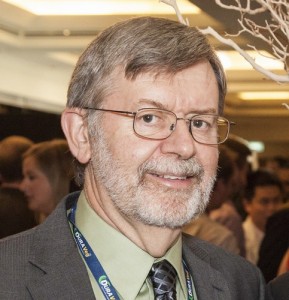Three ‘big ideas’ underpin BC vision for “Sustainable Watershed Systems, through Asset Management”: Primacy of Hydrology, Shifting Baseline Syndrome and Cathedral Thinking
Note to Reader:
For many years, the Partnership for Water Sustainability in British Columbia has been sending out weekly eNewsletters during the periods September through December and January through June. These celebrate the accomplishments of those leading and managing changes in standards of practice, especially those that are science-based and reflect “whole systems” thinking. Reproduced below is the eNewsletter that captured highlights of the keynote address by Kim Stephens at Stormwater 2016 in Queensland, Australia.

PARALLEL JOURNEYS: Australian conference showcased how British Columbia is moving towards a water-resilient future
In 2001, Kim Stephens was keynote speaker for an Urban Water Cycle Management Capacity Building Program for local governments in New South Wales, Australia. Fast forward to August 2016. His keynote presentation at Stormwater 2016: Rising to the Challenge, a national conference held in Queensland (Australia), provided him with a platform for reflecting on “parallel journeys” during the period 2001 through 2016. He explained how a changing climate resulted in “teachable moments” in British Columbia; and how a “regional team approach” guides implementation of a vision for Sustainable Watershed Systems, through Asset Management.

Plenary Session at Stormwater Australia 2016 Conference, Rising to the Challenge, held in Queensland
Focus on Legacy Outcomes & “Get It Right”
“Two keynote presentations in Australia over a 15-year period have allowed me to view our evolving BC situation in a comparative context,” stated Kim Stephens, Executive Director with the Partnership for Water Sustainability in BC. “Two weeks ago, the Rising to the Challenge conference was a milestone event. Because Australian practitioners are at a fork in their journey, they are looking to learn from BC experience. They are curious about our “whole systems” approach to water  balance management.”
balance management.”
“My due diligence in preparing for the keynote address involved interviewing a cross-section of “water thought leaders” from across Australia. Our conversations helped me identify over-arching themes that then shaped my storyline. The comparison process heightened my appreciation for the transformational potential of the “top-down & bottom-up” approach that characterizes collaboration in the BC local government setting.”
“Collaboration leads to sharing and learning from each other. Yet context is everything. For this reason, a common understanding of the intent of the Province’s policy, program and regulatory framework is essential. In the coming months, the Partnership will shine the spotlight on GETTING IT RIGHT when it comes to practices that restore watershed health through application of ecosystem-based understanding.”
“As we launch another season of weekly eNewsletters, the Partnership for Water Sustainability in BC reaffirms our commitment to celebrating the work of champions – whether individual or organizational – who are demonstrating that “designing with nature” does make a difference. The Partnership mission is to help our provincial and local government partners deliver and showcase legacy outcomes through programs such as the Georgia Basin Inter-Regional Educational Initiative (IREI).”
Towards Sustainable Watershed Systems
“In my 2016 keynote, I introduced Australians to three “big ideas” that underpin where we are heading in BC, namely: Primacy of Hydrology, Shifting Baseline Syndrome, and Cathedral Thinking. The three are interconnected. The outcome would be Sustainable Watershed Systems.
- Changes in hydrology, not water quality, must be the primary focus of rainwater management and green infrastructure practices. If we get the hydrology right, water quality typically takes care of itself, especially in a residential development.
- Coined by University of British Columbia’s Dr. Daniel Pauly, the Shifting Baseline Syndrome describes an incremental and imperceptible eroding of expectations and standards that results from each new generation lacking knowledge of the historical condition of the environment.
- The good news is that redevelopment creates an opportunity. If we can get the hydrology right the second time, and restore the water balance, we can then reset the ecological baseline.
- Achieving this outcome would take time, inter-generational commitment, and perseverance. This is the essence of “cathedral thinking” which describes our BC vision for Sustainable Watershed Systems.”
“In embarking on the journey to a water-resilient future, we can learn from our ancestors. The foundation for cathedral thinking is a far-reaching vision, a well thought-out blueprint, and long-term implementation.”
“These ideas resonated with the audience in Australia, and opened eyes and minds to a different way of thinking,” concluded Kim Stephens.
To Learn More:
Download Parallel Journeys to a Resilient Future: Water Cycle / Water Balance Approaches in Australia and British Columbia – 2001 to 2016 and Beyond to view a PDF copy of the PowerPoint presentation by Kim Stephens.

TO VIEW A TEDTALK VIDEO OF DANIEL PAULY, GO TO: http://mission-blue.org/2012/03/shifting-baselines-daniel-paulys-ted-talk/ < Daniel Pauly tells the story of how he came to coin the phrase “Shifting Baseline Syndrome” in 1995 >

